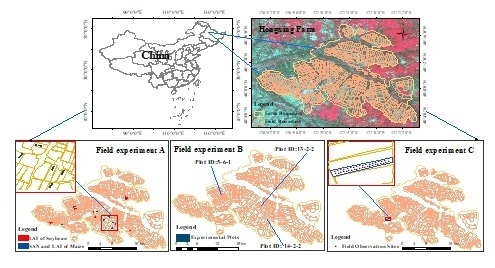Preliminary Study of Soil Available Nutrient Simulation Using a Modified WOFOST Model and Time-Series Remote Sensing Observations
Abstract
:1. Introduction
2. Materials and Methods
2.1. Study Area and Field Campaign
2.2. RS Data and Processing
2.3. WOFOST Model
2.4. T-RS Observations Assimilation
2.5. WOFOST Model Modification
2.6. SAN Simulation Algorithm
3. Experimental Results
3.1. Calibration of WOFOST Model
3.2. Calibration of Soil Nutrient Absorption Equation
3.3. Effect of Soil Nutrient Stress on Crop Growth
3.4. Crop Growth Simulations
3.5. SAN Simulation
3.6. The Application Value of the SAN Simulation Algorithm
4. Discussion
5. Conclusions
Acknowledgments
Author Contributions
Conflicts of Interest
References
- Robert, P. Precision agriculture: A challenge for crop nutrition management. Plant Soil 2002, 247, 143–149. [Google Scholar] [CrossRef]
- Robertson, M.J.; Llewellyn, R.S.; Mandel, R.; Lawes, R.; Bramley, R.G.V.; Swift, L.; Metz, N.; O’Callaghan, C. Adoption of variable rate fertiliser application in the Australian grains industry: Status, issues and prospects. Precis. Agric. 2012, 13, 181–199. [Google Scholar] [CrossRef]
- Basso, B.; Dumont, B.; Cammarano, D.; Pezzuolo, A.; Marinello, F.; Sartori, L. Environmental and economic benefits of variable rate nitrogen fertilization in a nitrate vulnerable zone. Sci. Total Environ. 2016, 545, 227–235. [Google Scholar] [CrossRef] [PubMed]
- Basso, B.; Cammarano, D.; Fiorentino, C.; Ritchie, J.T. Wheat yield response to spatially variable nitrogen fertilizer in Mediterranean environment. Eur. J. Agron. 2013, 51, 65–70. [Google Scholar] [CrossRef]
- Reyes, J.F.; Esquivel, W.; Cifuentes, D.; Ortega, R. Field testing of an automatic control system for variable rate fertilizer application. Comput. Electron. Agric. 2015, 13, 260–265. [Google Scholar] [CrossRef]
- Janik, L.J.; Merry, R.H.; Skjemstad, J.O. Can mid infrared diffuse reflectance analysis replace soil extractions? Aust. J. Exp. Agric. 1998, 38, 681–696. [Google Scholar] [CrossRef]
- Lamsal, S. Visible near-infrared reflectance spectrocopy for geospatial mapping of soil organic matter. Soil Sci. 2009, 174, 35–44. [Google Scholar] [CrossRef]
- Meng, J.; You, X.; Cheng, Z. Evaluating soil available nitrogen status with remote sensing. In Proceedings of the ECPA 10: The 10th European Conference on Precision Agriculture, The Tel Aviv-Yafo, Israel, 12–16 July 2015; pp. 681–696. [Google Scholar]
- Zheng, G.; Ryu, D.; Jiao, C.; Hong, C. Estimation of organic matter content in coastal soil using reflectance spectroscopy. Pedosphere 2016, 26, 130–136. [Google Scholar] [CrossRef]
- Leon, C.T.; Shaw, D.R.; Cox, M.S.; Abshire, M.J.; Ward, B.; Wardlaw, M.C., III; Watson, C. Utility of remote sensing in predicting crop and soil characteristics. Precis. Agric. 2003, 4, 359–384. [Google Scholar] [CrossRef]
- Mabhaudhi, T.; Modi, A.T.; Beletse, Y.G. Parameterisation and evaluation of the FAO-AquaCrop model for a South African taro (Colocasia esculenta L. Schott) landrace. Agric. For. Meteorol. 2014, 193, 132–139. [Google Scholar] [CrossRef]
- Gerakis, A.; Ritchie, J.T. Simulation of atrazine leaching in relation to water-table management using the CERES model. J. Environ. Manag. 1998, 52, 241–258. [Google Scholar] [CrossRef]
- Ma, H.; Huang, J.; Zhu, D.; Liu, J.; Su, W.; Zhang, C.; Fan, J. Estimating regional winter wheat yield by assimilation of time series of HJ-1 CCD NDVI into WOFOST-ACRM model with ensemble Kalman filter. Math. Comput. Model. 2013, 58, 759–770. [Google Scholar] [CrossRef]
- Boogaard, H.; Wolf, J.; Supit, I.; Niemeyer, S.; van Ittersum, M. A regional implementation of WOFOST for calculating yield gaps of autumn-sown wheat across the European Union. Field Crops Res. 2013, 143, 130–142. [Google Scholar] [CrossRef]
- Huang, J.; Ma, H.; Su, W.; Zhang, X.; Huang, Y.; Fan, J.; Wu, W. Jointly assimilating MODIS LAI and ET products into the SWAP model for winter wheat yield estimation. IEEE J. Sel. Top. Appl. Earth Obs. Remote Sens. 2015, 8, 4060–4071. [Google Scholar] [CrossRef]
- Ma, G.; Huang, J.; Wu, W.; Fan, J.; Zou, J.; Wu, S. Assimilation of MODIS-LAI into the WOFOST model for forecasting regional winter wheat yield. Math. Comput. Model. 2013, 58, 634–643. [Google Scholar] [CrossRef]
- Maas, S.J. Using satellite data to improve model estimates of crop yield. Agron. J. 1998, 80, 665–672. [Google Scholar] [CrossRef]
- De Wit, A.J.W.; van Diepen, C.A. Crop model data assimilation with the Ensemble Kalman filter for improving regional crop yield forecasts. Agric. For. Meteorol. 2007, 146, 38–56. [Google Scholar] [CrossRef]
- Huang, J.; Sedano, F.; Huang, Y.; Ma, H.; Li, X.; Liang, S.; Tian, L.; Zhang, X.; Fan, J.; Wu, W. Assimilating a synthetic Kalman filter leaf area index series into the WOFOST model to improve regional winter wheat yield estimation. Agric. For. Meteorol. 2016, 216, 188–202. [Google Scholar] [CrossRef]
- Chen, Y.; Cournède, P.H. Data assimilation to reduce uncertainty of crop model prediction with convolution particle filtering. Ecol. Model. 2014, 290, 165–177. [Google Scholar] [CrossRef]
- Dong, Y.; Zhao, C.; Yang, G.; Chen, L.; Wang, J.; Feng, H. Integrating a very fast simulated annealing optimization algorithm for crop leaf area index variational assimilation. Math. Comput. Model. 2013, 58, 877–885. [Google Scholar] [CrossRef]
- Huang, J.; Tian, L.; Liang, S.; Ma, H.; Inbal, B.R.; Su, W.; Huang, Y.; Zhang, X.; Zhu, D.; Wu, W. Improving winter wheat yield estimation by assimilation of the leaf area index from landsat TM and MODIS data into the WOFOST model. Agric. For. Meteorol. 2015, 204, 106–121. [Google Scholar] [CrossRef]
- Cochran, W.G. Sampling Techniques, 3rd ed.; Wiley: New York, NY, USA, 1977. [Google Scholar]
- Li-Cor. LAI-2000 Plant Canopy Analyser: Instruction Manual; LI–COR, Inc.: Lincoln, NE, USA, 1992. [Google Scholar]
- Soumit, K.B.; Pankaj, S.; Uday, V.P.; Rakesh, T. An indirect method of estimating leaf area index in Jatropha curcas L. using LAI-2000 Plant Canopy Analyzer. Agric. For. Meteorol. 2010, 150, 307–311. [Google Scholar]
- Qu, Y.; Meng, J.; Wan, H.; Li, Y. Preliminary study on integrated wireless smart terminals for leaf area index measurement. Comput. Electron. Agric. 2016, 129, 56–65. [Google Scholar] [CrossRef]
- Chen, B.; Wu, Z.; Wang, J.; Dong, J.; Guan, L.; Chen, J.; Yang, K.; Xie, G. Spatio-temporal prediction of leaf area index of rubber plantation using HJ-1A/1B CCD images and recurrent neural network. ISPRS J. Photogramm. 2015, 102, 148–160. [Google Scholar] [CrossRef]
- Li, H.; Cheng, Z.; Jiang, Z.; Wu, W.; Ren, J.; Liu, B.; Hasi, T. Comparative analysis of GF-1, HJ-1, and Landsat-8 data for estimating the leaf area index of winter wheat. JIA 2015, 16, 266–285. [Google Scholar] [CrossRef]
- Van Diepen, C.A.; Wolf, J.; van Keulen, H.; Rappoldt, C. WOFOST: A simulation model of crop production. Soil Use Manag. 1989, 5, 16–24. [Google Scholar] [CrossRef]
- Darvishzadeh, R.; Skidmore, A.; Schlerf, M.; Atzberger, C. Inversion of a radiative transfer model for estimating vegetation LAI and chlorophyll in a heterogeneous grassland. Remote Sens. Environ. 2008, 112, 2592–2604. [Google Scholar] [CrossRef]
- Propastin, P.; Erasmi, S. A physically based approach to model LAI from MODIS 250 m data in a tropical region. Int. J. Appl. Earth Obs. Geoinf. 2010, 12, 47–59. [Google Scholar] [CrossRef]
- Berterretche, M.; Hudak, A.T.; Cohen, W.B.; Maiersperger, T.K.; Gower, S.T.; Dungan, J. Comparison of regression and geostatistical methods for mapping Leaf Area Index (LAI) with landsat ETM+ data over a Boreal forest. Remote Sens. Environ. 2005, 96, 49–61. [Google Scholar] [CrossRef]
- Cheng, Z.; Meng, J.; Wang, Y. Improving spring maize yield estimation at field scale by assimilating time-series HJ-1 CCD Data into the WOFOST model using a new method with fast algorithms. Remote Sens. 2016, 8, 303. [Google Scholar] [CrossRef]
- Burgers, G.; van Leeuwen, P.J.; Evensen, G. Analysis scheme in the ensemble Kalman filter. Mon. Weather Rev. 1998, 126, 1719–1724. [Google Scholar] [CrossRef]
- Osaki, M. Comparison of productivity between tropical and temperate maize. Soil Sci. Plant Nutr. 1995, 41, 451–459. [Google Scholar] [CrossRef]
- Nyiraneza, J.; N’Dayegamiye, A.; Chantigny, M.H.; Laverdière, M.R. Variations in corn yield and nitrogen uptake in relation to soil attributes and nitrogen availability indices. Soil Sci. Soc. Am. J. 2009, 73, 317–327. [Google Scholar] [CrossRef]
- De Neve, S.; Hofman, G. Influence of soil compaction on carbon and nitrogen mineralization of soil organic matter and crop residues. Biol. Fertil. Soil 2000, 30, 544–549. [Google Scholar] [CrossRef]
- Gao, N.; Liu, Y.; Wu, H.; Zhang, P.; Na, Y.; Zhang, Y.; Zou, H.; Fan, Q.; Zhang, Y. Interactive effects of irrigation and nitrogen fertilizer on yield, nitrogen uptake, and recovery of two successive Chinese cabbage crops as assessed using 15 N isotope. Sci. Hortic. 2017, 215, 117–125. [Google Scholar] [CrossRef]
- Liu, M.; Sun, J.; Li, Y.; Xiao, Y. Nitrogen fertilizer enhances growth and nutrient uptake of Medicago sativa inoculated with Glomus tortuosum grown in Cd-contaminated acidic soil. Chemosphere 2017, 167, 204–211. [Google Scholar] [CrossRef] [PubMed]
- Song, H.; Li, S. Dynamics of nutrient accumulation in maize plants under different water and N supply conditions. JIA 2002, 1, 52–59. [Google Scholar]
- Taize, L.; Zeiger, E. Plant Physiology, 5rd ed.; Sinauer Associates Inc.: Sunderland, UK, 2010. [Google Scholar]


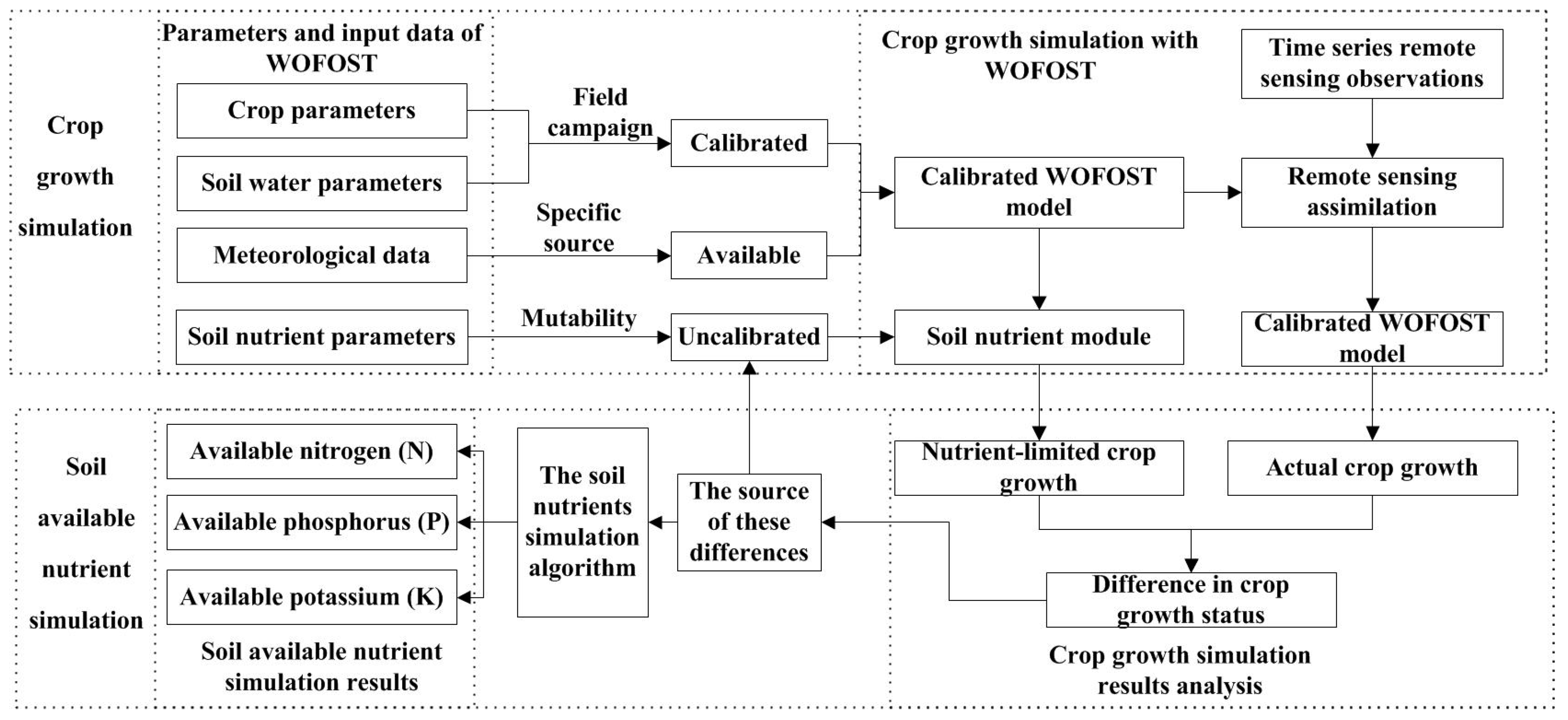
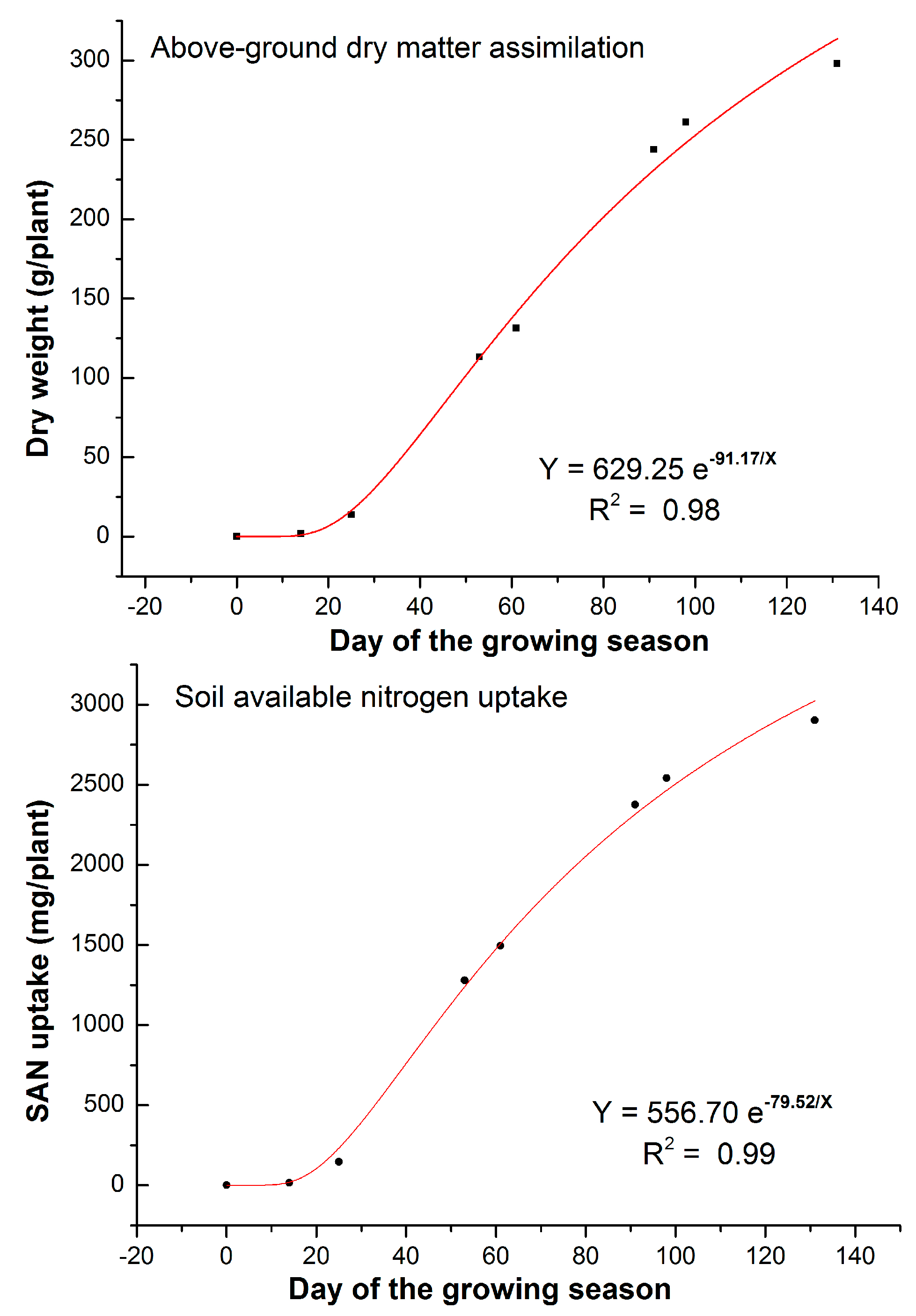
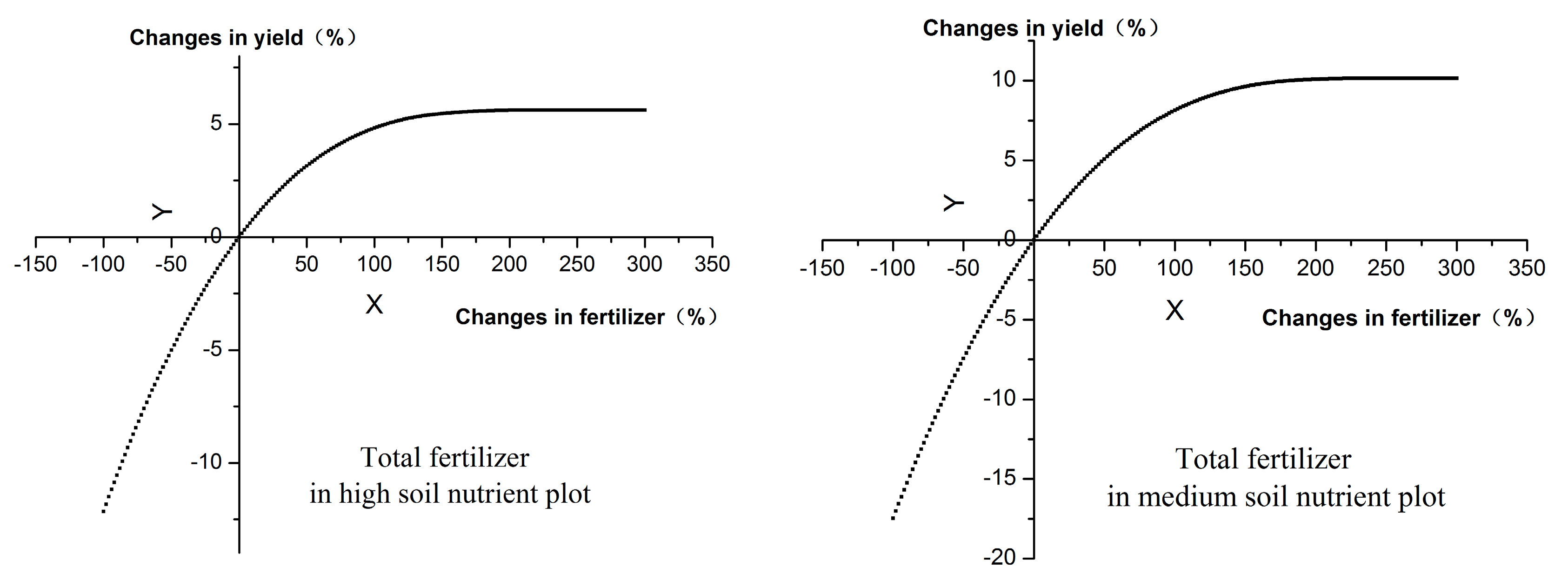

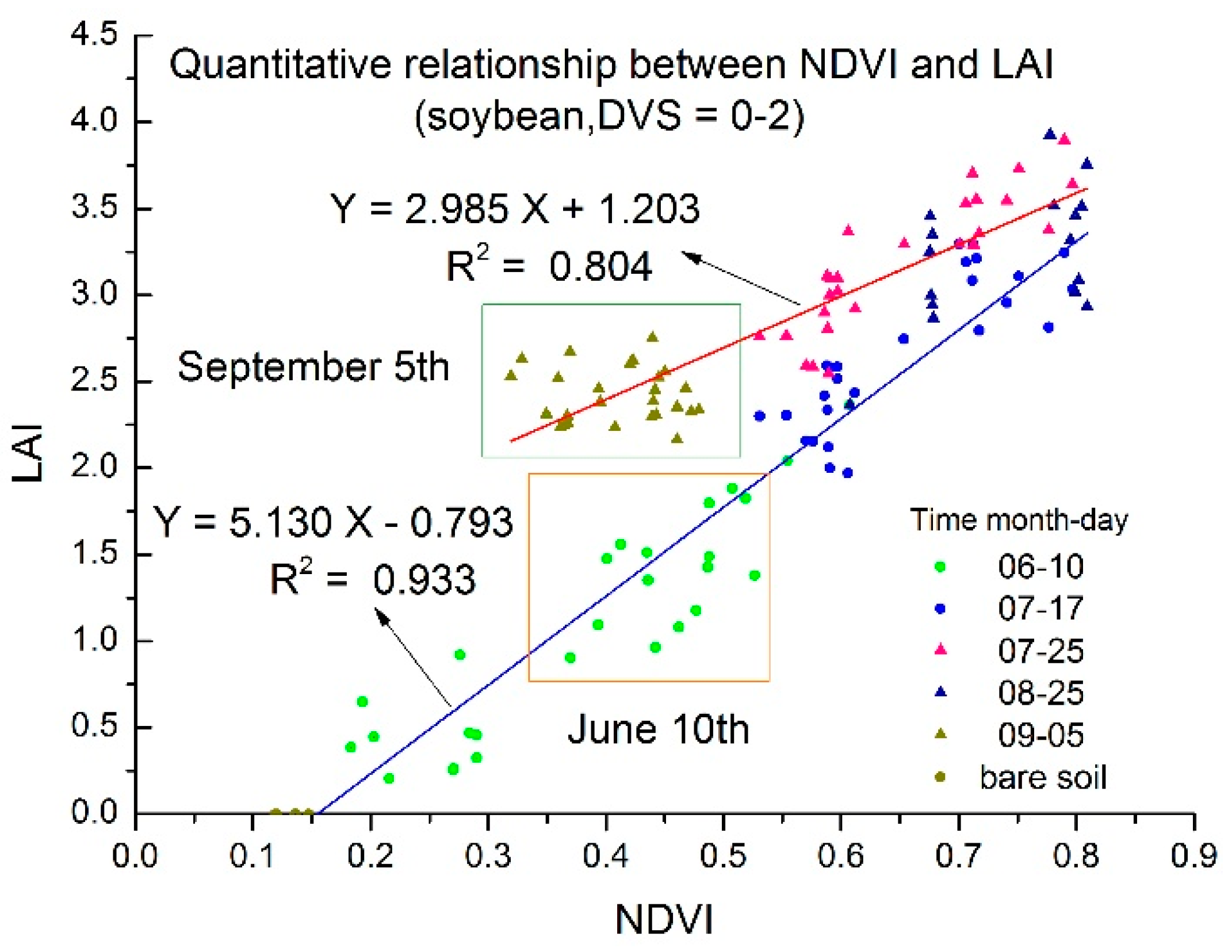
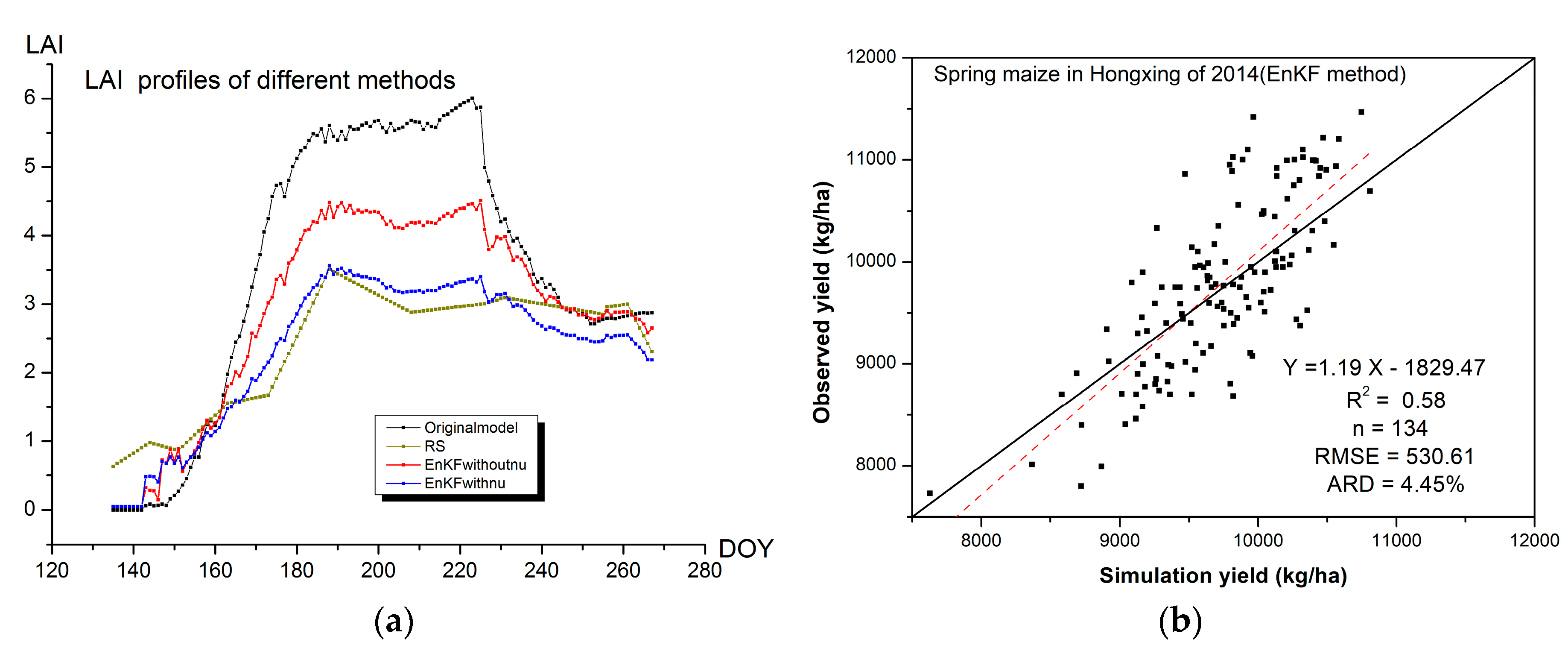
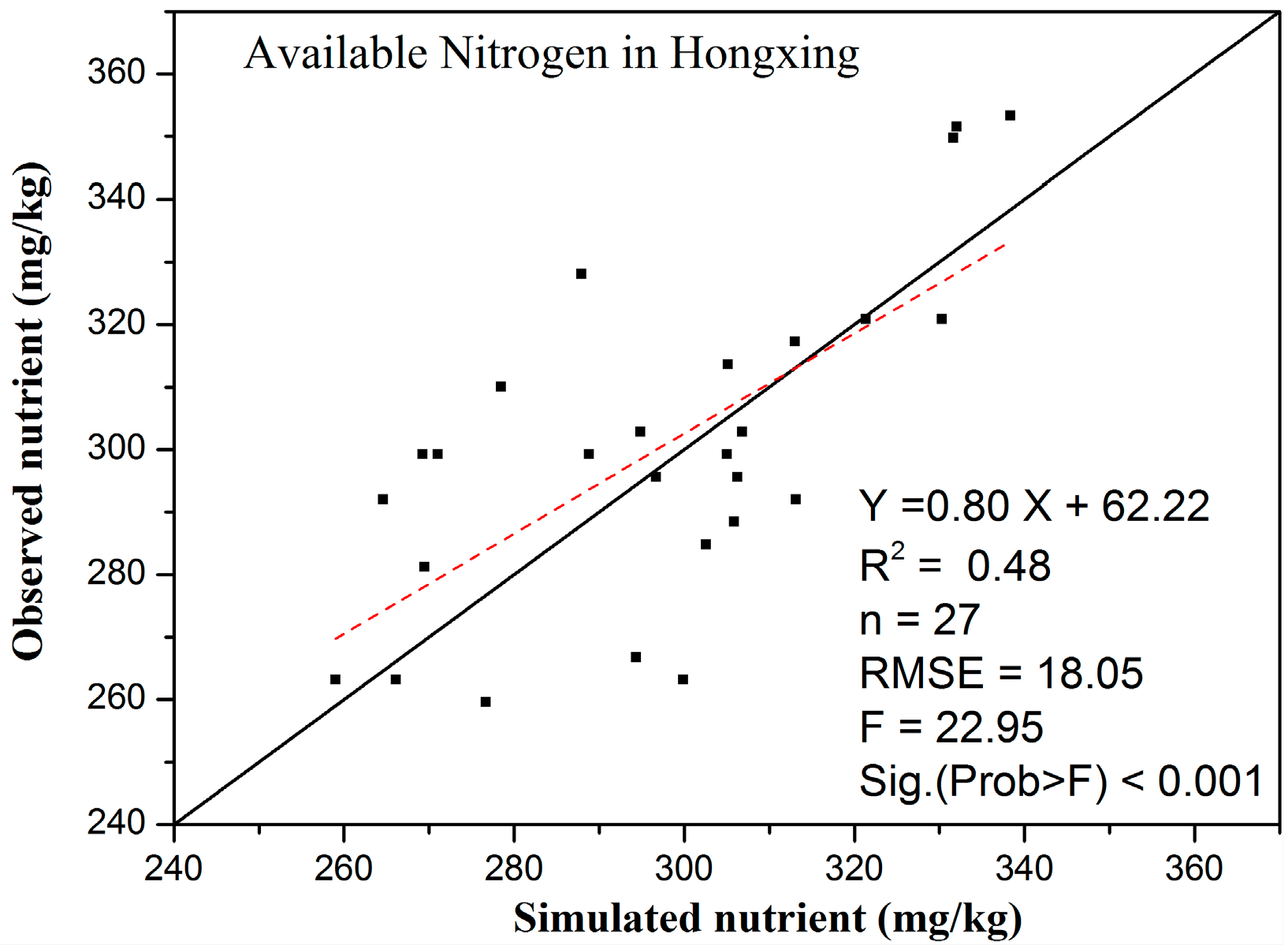
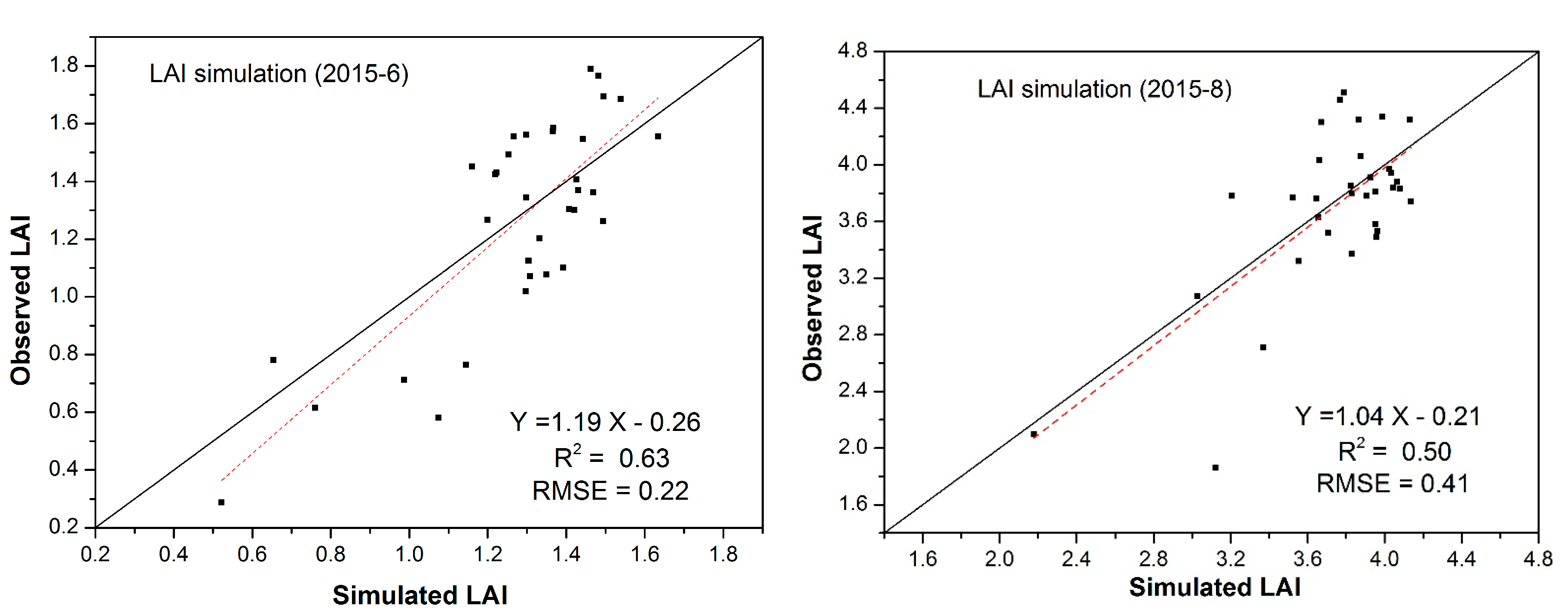
| SAN (kg/ha) | Depth (m) | DOG (Day) | Input Biomass of Point A (kg/ha) | Input Biomass of Point B (kg/ha) | LAI | ||||||
|---|---|---|---|---|---|---|---|---|---|---|---|
| N | Min (Root, Black Soil) | Point A | Point B | Leaf | Stem | Storage Organs | Leaf | Stem | Storage Organs | Input | Output |
| 420 | 1.0 | 20 | 80 | 800 | 1200 | 0 | 3200 | 3300 | 400 | 2.75 | 2.57 |
| 320 | 1.0 | 20 | 80 | 800 | 1200 | 0 | 3200 | 3300 | 400 | 2.75 | 2.52 |
| 220 | 1.0 | 20 | 80 | 800 | 1200 | 0 | 3200 | 3300 | 400 | 2.75 | 2.48 |
| 420 | 1.1 | 30 | 90 | 1500 | 1600 | 50 | 3700 | 3700 | 800 | 2.85 | 2.70 |
| 320 | 1.1 | 30 | 90 | 1500 | 1600 | 50 | 3700 | 3700 | 800 | 2.85 | 2.67 |
| 220 | 1.1 | 30 | 90 | 1500 | 1600 | 50 | 3700 | 3700 | 800 | 2.85 | 2.63 |
| 420 | 0.9 | 1 | 60 | 10 | 5 | 0 | 1600 | 1700 | 200 | 2.55 | 2.43 |
| 320 | 0.9 | 1 | 60 | 10 | 5 | 0 | 1600 | 1700 | 200 | 2.55 | 2.39 |
| 220 | 0.9 | 1 | 60 | 10 | 5 | 0 | 1600 | 1700 | 200 | 2.55 | 2.33 |
| Value Range | Sensitivity Level | Description |
|---|---|---|
| 0.00–0.05 | 1 | Insensitivity |
| 0.05–0.20 | 2 | General sensitivity |
| 0.20–1.00 | 3 | Sensitivity |
| 1.00–2.00 | 4 | Significant sensitivity |
| >2.00 | 5 | Highly significant sensitivity |
| Parameters | Description | Values | Unit | Sensitivity Value |
|---|---|---|---|---|
| TSUM1 | Temperature sum from emergence to anthesis | 890 | °C*d | 2.82 |
| TSUM2 | Temperature sum from anthesis to maturity | 710 | °C*d | 2.75 |
| CVL | Conversion efficiency of assimilates into leaf | 0.65 | kg/kg | 1.35 |
| CVO | Conversion efficiency of assimilates into storage organ | 0.82 | kg/kg | 0.56 |
| CVR | Conversion efficiency of assimilates into root | 0.72 | kg/kg | 0.34 |
| CVS | Conversion efficiency of assimilates into stem | 0.69 | kg/kg | 0.49 |
| FRTB | Fraction of total dry matter to root | 0–0.40 | kg/kg | 1.31 |
| FOTB | Fraction of above ground dry matter to storage organs (DVS = 0.1–1.7) | 0–0.73 | kg/kg | 1.56 |
| FLTB | Fraction of above ground dry matter to leaves (DVS = 0.1–1.7) | 0.19–0.77 | kg/kg | 2.23 |
| FSTB | Fraction of above ground dry matter to stem (DVS = 0.1–1.7) | 0.08–0.55 | kg/kg | 1.44 |
| NBASE | Mean basic soil nitrogen content | 316 | mg/kg | 2.11 |
| PBASE | Mean basic phosphorus content | 40 | mg/kg | 1.23 |
| KBASE | Mean basic potassium content | 176 | mg/kg | 1.45 |
| NF | Quantity of nitrogen fertilizer | 261.5 | kg/ha | 0.98 |
| PF | Quantity of phosphorus fertilizer | 138 | kg/ha | 0.43 |
| KF | Quantity of potassium fertilizer | 150.5 | kg/ha | 0.66 |
| SMTAB | Volumetric moisture content (pF = −1–6) | 0.084–0.41 | cm3/cm3 | 0.22 |
| SMFCF | Soil moisture content at field capacity | 0.295 | cm3/cm3 | 0.22 |
| SMW | Soil moisture content at wilting point | 0.084 | cm3/cm3 | 0.34 |
| SM0 | Soil moisture content of saturated soil | 0.41 | cm3/cm3 | 0.21 |
| RDMCR | Maximum root depth allowed by soil | 0–2.5 | m | 1.20 |
| Name | Method | Values | Error |
|---|---|---|---|
| Emergence time (month-day) | Observed results | 28 May | - |
| Original model | 23 May | −5 days | |
| Calibrated model | 26 May | −2 days | |
| Anthesis time (month-day) | Observed results | 24 July | - |
| Original model | 15 July | −9 days | |
| Calibrated model | 27 July | 3 days | |
| Maturity time (month-day) | Observed results | 26 September | - |
| Original model | 22 September | −4 days | |
| Calibrated model | 28 September | 2 days | |
| Yield (kg/ha) | Observed results | 9808.20 | - |
| Original model | 9607.67 | −200.53 | |
| Calibrated model | 9767.70 | −40.50 |
| Coefficient Type | a (g/Plant) | c |
|---|---|---|
| N | 4.42 | 79.52 |
| P | 1.08 | 87.60 |
| K | 4.49 | 71.30 |
| Year | Area (ha) | Fertilizer | Yield (kg/ha) |
|---|---|---|---|
| 2010 | 3 | Variable rate fertilization | 9735 |
| 2010 | 9 | Normal | 8905 |
| 2014 | 26 | Normal | 9645 |
| 2014 | 25 | 5% fertilizer reduction | 9451 |
| 2014 | 20 | 10% fertilizer reduction | 8598 |
| Plot Number | 13-2-2 | 14-2-2 | 5-6-1 | Farm Mean Value |
|---|---|---|---|---|
| Soil fertility | High nutrient field | Medium nutrient field | Low nutrient field | - |
| N (mg/kg) | 378.81 | 325.48 | 267.38 | 315.00 |
| P (mg/kg) | 44.98 | 39.60 | 33.39 | 40.00 |
| K (mg/kg) | 198.73 | 173.71 | 174.83 | 175.00 |
| Fertilization in 2014 (kg/ha) | 700.00 | 700.00 | 700.00 | 700.00 |
| Actual yield of 2014 (kg/ha) | 11,295.00 | 10,031.47 | 9588.25 | 9808.20 |
| Simulated yield of 2014 (kg/ha) | 11,013.20 | 10,761.10 | 9639.38 | 9686.28 |
| Time (Month-Day) | Model | R2 | F | RMSE |
|---|---|---|---|---|
| DVS = 0–1 | Y = 5.828X − 0.784 | 0.96 | 980.02 | 0.22 |
| DVS = 1–2 | Y = 4.564X + 0.026 | 0.80 | 233.64 | 0.19 |
| Index | Method | R2 | Method | R2 |
|---|---|---|---|---|
| Yield | Nutrient-limited growth | 0.36 | Actual growth | 0.58 |
| LAI05 | Nutrient-limited growth | 0.78 | Actual growth | 0.84 |
| LAI10 | Nutrient-limited growth | 0.52 | Actual growth | 0.65 |
| LAI15 | Nutrient-limited growth | 0.63 | Actual growth | 0.79 |
| Nutrient | Method | Time (DOG) | Index | R2 |
|---|---|---|---|---|
| N | New approach | 43 | - | 0.48 |
| N | Statistic model | 23 | NIR | 0.14 |
| P | New approach | 53 | - | 0.37 |
| P | Statistic model | 57 | NDVI | 0.17 |
| K | New approach | 63 | - | 0.15 |
| K | Statistic model | 57 | RVI | 0.09 |
| Plot Name | Fertilization (kg/ha) | Observed Yield (kg/ha) | Simulated Yield with VF (kg/ha) | Yield Increment (kg/ha) |
|---|---|---|---|---|
| 13-2-2 | 700.00 | 11,295.00 | 12,215.30 | 920.30 |
| 14-2-2 | 700.00 | 10,031.47 | 11,102.55 | 1071.08 |
| 5-6-1 | 700.00 | 9588.25 | 10,967.67 | 1379.42 |
| VF experiment in 2010 | 700.00 | 8905.00 | 9735.00 | 830.00 |
| LAI (%) | N (%) | P (%) | K (%) |
|---|---|---|---|
| 90 | 91 | 88 | 93 |
| 95 | 94 | 94 | 96 |
| 100 | 100 | 100 | 100 |
| 105 | 104 | 107 | 105 |
| 110 | 108 | 113 | 112 |
© 2018 by the authors. Licensee MDPI, Basel, Switzerland. This article is an open access article distributed under the terms and conditions of the Creative Commons Attribution (CC BY) license (http://creativecommons.org/licenses/by/4.0/).
Share and Cite
Cheng, Z.; Meng, J.; Qiao, Y.; Wang, Y.; Dong, W.; Han, Y. Preliminary Study of Soil Available Nutrient Simulation Using a Modified WOFOST Model and Time-Series Remote Sensing Observations. Remote Sens. 2018, 10, 64. https://doi.org/10.3390/rs10010064
Cheng Z, Meng J, Qiao Y, Wang Y, Dong W, Han Y. Preliminary Study of Soil Available Nutrient Simulation Using a Modified WOFOST Model and Time-Series Remote Sensing Observations. Remote Sensing. 2018; 10(1):64. https://doi.org/10.3390/rs10010064
Chicago/Turabian StyleCheng, Zhiqiang, Jihua Meng, Yanyou Qiao, Yiming Wang, Wenquan Dong, and Yanxin Han. 2018. "Preliminary Study of Soil Available Nutrient Simulation Using a Modified WOFOST Model and Time-Series Remote Sensing Observations" Remote Sensing 10, no. 1: 64. https://doi.org/10.3390/rs10010064




